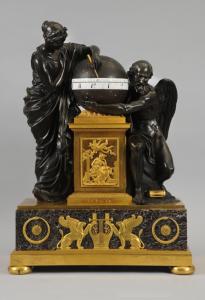Tempo! – On the Time Factor in the Furnishing Practice of the French Empire
Tempo! – On the Time Factor in the Furnishing Practice of the French Empire
“Il y a une espèce de voleur que les lois ne recherchent pas, et qui dérobe ce que les hommes ont de plus précieux: le temps.” Napoleon Bonaparte (1769–1821)1
“Good things take time” (Gut Ding will Weil haben) goes an old German proverb that, applied to the decorative arts, determines time to be the decisive factor in the manufacture of luxury products. The corresponding French saying – “You can't throw it into a mould” (Cela ne se jette pas en moule) – invokes, in addition to the time aspect, the degree of difficulty, as in something precluding simple production.2 The artisanal processes in the area of the spatial and decorative arts around 1800 that are of interest in this project unfolded over time, with the workflow including the procurement, preparation, and working of materials and finally the configuration, installation, or sale of the end products. Whether alone, in consultation with architects, draftsmen, and patrons, or jointly with other trades, each fabrication required a high degree of coordination ("Synchronisation") of highly specialized and generally time-consuming stages of work.3
But time had become a precious commodity, first of all in the perception of time ("Zeitempfinden") of post-revolutionary society, which had witnessed the collapse of the old orders of the world and of time.4 In his lectures on the “Geschichte des Zeitalters der Revolution” of 1829, Barthold Georg Niebuhr (1776–1831) retrospectively formulated his impression that after the French Revolution people began “to live faster and more intensely than before” ("geschwinder und intensiver als früher zu leben")5, a sense of time confirmed also in epistolary literature and memoires of the Napoleonic period. While Niebuhr specifically saw improved road networks and post offices as causes of a new intensity of life, these letters and memoires demonstrate – in addition to the need to make up for the “lost time” of the revolutionary years – a pronounced urge to live, a desire to live the moment.6 Both resulted in increased consumerism, which, for the French elite, was often financed by Napoleon, who understand how to use the strategic advantage of time – as well as the lifetimes that his followers also made available for his numerous wars – for his political agenda (“chronopolitics”). Mobility, speed, and reactivity were the decisive advantages with which Napoleon sought to overcome traditional space and time relations.7 The resulting new experience of time also affected pre-technological and pre-industrial luxury production in the French decorative arts – in the sense of an acceleration ("Beschleunigung") that, until now, has never been precisely defined for the Napoleonic period.8
Essential to the representation of the new regime, the Empire style created for Napoleon by Charles Percier (1764–1838) and Pierre-François Léonard Fontaine (1762–1853), with its formal language borrowed from the Roman Empire, achieved its full effect most impressively in the decorative arts. It is this material legacy of the Empire – the wall paneling, decorative paintings, furniture, silk fabrics, gilded bronzes, and porcelain, with the manufacturers and craftsmen in interaction with a highly specialized art market and a well-organized administration – that made the Napoleonic regime sensorially and materially vivid, made it “tangible” in the best sense of the word. The somewhat generous time frames that still existed in the pre-revolutionary period for the realization of interior decorations or the production of luxury goods were hardly to be found in the Empire. A very early example of a building project that was determined notably by the narrow time constraints (of Napoleon, in this case) is the furnishing of a council chamber in the Château de Malmaison in the year 1800. A construction period of only one “decade” as noted in the Recueil de décorations intérieures – and measured according to the Republican calendar introduced in 1792 – determined the planning and material realization of this project, which, built into the existing volume of the room, in the end consisted of an inner tent in a simple wood/fabric construction.9 In the Recueil’s anecdote about artists, the pace of execution of the project is reinterpreted as evidence of the architects’ genius, of the French manufacturers’ efficiency, and, ultimately, of the patron’s organizational and administrative talent. On the contrary, the choice of materials and the craftsmanship are little discussed, as is the seemingly ephemeral result, which is situated somewhere between a stroke of genius and an aesthetic compromise.
It is here that this research project starts, seeking to examine the influences of new experiences of time on the production and the aesthetic of interior furnishings and decorative objects and their perception in France around 1800. Questions surrounding the history of technology and pre-industrial production are also central to the project, along with Napoleonic policy on art and culture, to be examined for attempts at acceleration and for industrialization tendencies in the production of decorative arts.10 Further topics of the project include: materiality/the Material Turn – the restructuring of working and organization processes – economic policy – the art market – the luxury industry – industrial promotion – the management of time and quality.11 This research project is enriched by exchanges with manufacturers, craftsmen, and conservators in the framework of the project in scientific support of conservation efforts “Scientific Work on the Hôtel Beauharnais,” and is open to interdisciplinary approaches.
***
1 Napoleon Bonaparte, Maximes et pensées du prisonnier de Sainte-Hélène, manuscrit trouvé dans les papiers de Las-Cases, traduit de l’anglais[JO1] , Commercy 1845, p. 125, no. 322.
2 Johannes Agricola, Sybenhundert vnd Fünfftzig Teütscher Sprichwörter, verneüwert vnd gebessert, Haguenau, 1534, no. 656; see also Karl Friedrich W. Wander (ed.), Deutsches Sprichwörter-Lexikon, 5 vols., Leipzig 1867–1880, vol. 1, 1867, p. 636, nos. 866 and 867. On the French proverb: Jean Pierre Louis, De Beauclair, Cour De Gallicismes, 4 vols., Frankfurt am Main 1794–1796, vol. 2, 1795, p. 107.
3 John Holloway and Edward P. Thompson, Blauer Montag. Über Zeit und Arbeitsdisziplin, Hamburg 2007.
4 On the experience of time around 1800, see especially these works from the fields of history and literary studies: Reinhart Koselleck and Rolf Reichardt (ed.), Die Französische Revolution als Bruch des gesellschaftlichen Bewußtseins: Vorlagen und Diskussionen der internationalen Arbeitstagung am Zentrum für Interdisziplinäre Forschung der Universität Bielefeld, 28. Mai–1. Juni 1985, Munich 1988; Ernst Wolfgang Becker, Zeit der Revolution! – Revolution der Zeit? Zeiterfahrungen in Deutschland in der Ära der Revolutionen; 1789–1848/49, Göttingen 1999; Alexander Honold, “Die Architektur der neuen Zeit. Der französische Revolutionskalender und seine Medienästhetik”, in Die Zeit schreiben: Jahreszeiten, Uhren und Kalender als Taktgeber der Literatur, Basel 2013, pp. 65–85.
5 Barthold Georg Niebuhr, Geschichte des Zeitalters der Revolution Vorlesungen an der Universität zu Bonn im Sommer 1829 gehalten, Hamburg 1845, pp. 54–55; interpreted in this sense by Ernst Wolfgang Becker, op. cit., p. 11
6 The latter resulted from the uncertainty of the almost continuous war situation between 1800 and 1815. See Natalie Petiteau, “Les Français face au temps de l’Empire”, in Revue d’histoire du XIXe siècle. Société d’histoire de la révolution de 1848 et des révolutions du XIXe siècle 25, 2002 (“Le temps et les historiens”), pp. 29–41, online: http://journals.openedition.org/rh19/417; Ernst Wolfgang Becker, op. cit., p. 11.
7 On chronopolitics, see also Paul Virilio, Geschwindigkeit und Politik: ein Essay zur Dromologie, Berlin 1980. For Napoleon’s relationship to “time”, see among others Berthold Vallentin, Napoleon, Berlin 1923.
8 The period around 1800 is passed over in most current works of sociology and philosophy, for example, the fundamental work on social acceleration by Hartmut Rosa (idem, Beschleunigung: die Veränderung der Zeitstrukturen in der Moderne, Frankfurt am Main 2010, p. 24).
9 Recueil de décorations intérieures comprenant tout ce qui a rapport à l’ameublement, comme vases, trépieds, candélabres, cassolettes, lustres, girandoles, lampes, chandeliers, cheminées, feux, poêles, pendules, tables, secrétaires, lits, canapés, fauteuils, chaises, tabourets, miroirs, écrans, &c. &c. &c., composés par C. Percier et P. F. L. Fontaine, exécutés sur leurs dessins, Paris, 1801–1812, p. 39, plate LV; see also Pierre François Léonard Fontaine, Journal : 1799–1853, 2 vols., Paris, École nationale supérieure des Beaux-Arts, 1987, vol. 1, p. 10 (entry on the “10 pluviôse” (30 January 1800): “[le] Premier Consul qui paraît disposé à venir y [to Malmaison] prendre l’air tous les dix jours”); on the working process: Bernard Chevallier, Malmaison : château et domaine des origines à 1904, Paris 1989, pp. 91–93.
10 See also Michael P. Fitzsimmons, From Artisan to Worker: Guilds, the French State, and the Organization of Labor, 1776–1821, Cambridge 2010.
11 On early industrialization, see among others André Guillerme, La naissance de l’industrie à Paris : entre sueurs et vapeurs, 1780–1830, Seyssel 2007, who deliberately passes over luxury manufacturers; Thomas Le Roux (ed.), Les Paris de l’industrie 1750–1920 : Paris au risque de l’industrie, exh. cat. Paris, Réfectoire des Cordeliers, Grane 2013.
Researcher





